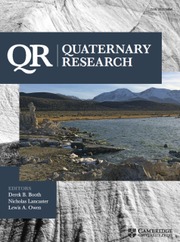No CrossRef data available.
Article contents
Late glacial and Holocene climate and landscape dynamics in the Valdai Highlands (East European Plain) inferred from lake sediment records
Published online by Cambridge University Press: 01 September 2025
Abstract
The results of a ground-penetrating radar survey and multiproxy studies of the sediment cores collected from two lakes in the Valdai Highlands (East European Plain) provide new insights into the late glacial and Holocene environmental history of the region situated in the marginal zone of the last Scandinavian ice sheet. The cores were analyzed for organic carbon and nitrogen content, as well as for pollen and diatoms. The chronology of the cores is based on radiocarbon dates and pollen-based stratigraphy. The studied records document that vast dead ice masses and associated ice-dammed lakes existed in the Valdai Highlands area until ∼14 cal ka BP. Open tundra-steppe communities dominated the study area during the Oldest Dryas, Bølling, and Older Dryas (between ca. 17 and 14 cal ka BP), but dwarf birch (Betula nana), shrub alder (Alnus fruticosa), and willow (Salix) were also common. Scots pine forest (Pinus sylvestris) became common for a short interval during the Bølling warming (ca. 14.9 and 14.4 cal ka BP). The appearance of spruce (Picea) forest in the landscape occurred in the beginning of the Allerød warming (∼14 cal ka BP), but the open steppe-like plant communities remained common until the onset of the Holocene. The modern lake systems emerged at ∼10 cal ka BP, marked by an onset of organic-type sedimentation and the appearance of modern-type forests. The Mid-Holocene (∼8–4 cal ka BP) was the warmest time, as documented by the maximal distribution of temperate and broadleaved taxa in the region. The onset of agricultural land use and simultaneous trend of increasing lake trophic state and increasing paludification in the area is recorded at ∼2.5 cal ka BP.
Information
- Type
- Research Article
- Information
- Copyright
- © The Author(s), 2025. Published by Cambridge University Press on behalf of Quaternary Research Center.


